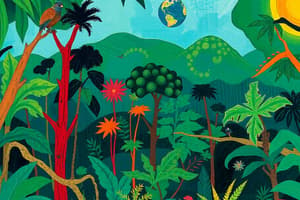Podcast
Questions and Answers
What is the primary threat to tropical rainforests mentioned in the text?
What is the primary threat to tropical rainforests mentioned in the text?
- Burning of land for agriculture (correct)
- Mining activities for precious metals
- Illegal logging for hardwood extraction
- Climate change due to greenhouse gas emissions
Which region has a mix of seasonal and evergreen forests dependent on water retention?
Which region has a mix of seasonal and evergreen forests dependent on water retention?
- South China to Taiwan
- Pacific islands within the tropics
- Australia
- Southeast Asia (correct)
What is the predominant forest type in the Philippines, Malaysia, and Indonesia?
What is the predominant forest type in the Philippines, Malaysia, and Indonesia?
- Deciduous forests
- Temperate forests
- Tropical rainforests (correct)
- Seasonal forests
Which family do many trees in Southeast Asia belong to, apart from teak?
Which family do many trees in Southeast Asia belong to, apart from teak?
What factor leads to lower biodiversity and the dominance of a single species in broad areas during the dry season?
What factor leads to lower biodiversity and the dominance of a single species in broad areas during the dry season?
What is the greatest threat to tropical rainforests in Brazil and Bolivia according to the text?
What is the greatest threat to tropical rainforests in Brazil and Bolivia according to the text?
What type of tropical forest experiences a pronounced dry season and sheds its leaves?
What type of tropical forest experiences a pronounced dry season and sheds its leaves?
Which forest layer hosts approximately half of all plant species and is the most biologically diverse?
Which forest layer hosts approximately half of all plant species and is the most biologically diverse?
Where are tropical rainforests primarily found?
Where are tropical rainforests primarily found?
Which region is NOT a dominant region with tropical forests?
Which region is NOT a dominant region with tropical forests?
Flashcards are hidden until you start studying
Study Notes
- Tropical forests are the most biodiverse ecosystems on Earth, with over half of all plant and animal species.
- They absorb more CO2 and produce more oxygen than any other biome.
- Two distinct types of tropical forests: perennial and seasonal.
- Perennial forests have no significant dry season and keep their leaves year-round.
- Seasonal forests experience a pronounced dry season and shed their leaves to conserve water.
- Suspended forest layer, or canopy, is nearly continuous and absorbs over 90% of sunlight.
- It hosts approximately half of all plant species and is the most biologically diverse layer.
- Epiphytes, parasitic plants like orchids and lianas, connect trees and create pathways for wildlife.
- Emergent forest layer, where tall trees extend above the canopy, is home to unique species adapted to harsh conditions.
- Tropical forests are the oldest biomes on Earth, with some estimates dating back 100 million years.
- They are found in the tropics, where temperatures remain high year-round.
- Tropical rainforests primarily exist in areas with tropical wet and monsoon climates.
- Some exceptions include areas with extensive flooding during the rainy season or high altitudes that push the climate towards a subtropical zone.
- Dominant regions with tropical forests include Central America, the Amazon Basin, and parts of Africa and Asia.
- Tropical forests provide vital ecosystem services, including carbon sequestration, water regulation, and habitat for numerous species.
- They are under threat from deforestation, agriculture, and other human activities, leading to biodiversity loss and climate change.- Sri Lanka primarily consists of evergreen forests due to year-round exposure to monsoon winds.
- Southeast Asian countries like Myanmar, Thailand, Laos, Cambodia, and Vietnam have a mix of seasonal and evergreen forests, dependent on water retention.
- South China to Taiwan also have a mix of tropical forest types.
- As we move towards Southeast Asia (Philippines, Malaysia, and Indonesia), evergreen forests predominate, making up the third largest tropical rainforest in the world.
- Australia has a narrow strip of tropical forest along its northern and northeastern coasts due to exposure to monsoon winds.
- Pacific islands within the tropics have evergreen forests, from the Solomon Islands to Fiji, Micronesia, and certain Hawaiian coasts.
- Tropical rainforests have the highest biodiversity on Earth, with over 375 tree species in a Malayan quarter-square kilometer.
- Most trees, including almost all hardwoods like teak, ebony, and palisandro, belong to the angiosperms.
- In the dry season, biodiversity is lower, and forests may be dominated by a single species in broad areas.
- Tree species distribution is divided into three subcategories: Neotropical, African, and Melanesian.
- In Central and South America, common trees include mahogany, cedar, laurel, palmera, acacia, palisandro, and Brazil nut.
- In Africa, trees include mahogany, ebony, limba, wenge, agba, iroko, and sapeli.
- In Southeast Asia, apart from teak, many trees belong to the dipterocarpus family, while others are durian, sandalwood, and ironwood.
- The destruction of tropical rainforests is a pressing issue, with agriculture now being the greatest threat.
- In Brazil and Bolivia, land is burned illegally to claim it as "dead" land for cattle ranching.
- In Southeast Asia, habitat destruction is at unprecedented levels due to palm oil demand.
- Witnessed from the air, vast areas of Indonesian and Malaysian forests have been converted into palm oil plantations.
- Many believe tropical forests cannot disappear: they are too large and valuable.
- However, precedents exist: forests that once covered England, India, and a dozen US states no longer exist.
- The destruction of natural habitats has a long history, dating back thousands of years.
- To accommodate the needs of a growing population in the tropics, we must learn to live sustainably or risk losing this precious ecosystem.
Studying That Suits You
Use AI to generate personalized quizzes and flashcards to suit your learning preferences.



